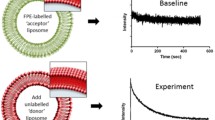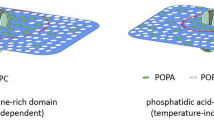Abstract
The fluorescence properties of the phospholipid derivative,N-[1-(2-naphthol)]-phosphatidylethanolamine (NAPH-PE), have been studied by steady-state and time-resolved fluorescence techniques. The new probe is a naphthol adduct of phosphatidylethanolamine. The emission spectrum of the fluorescent phospholipid depends on the pH and on the proton acceptor concentration as expected for a typical two-state excited-state proton transfer reaction. In ethanol solutions at an apparent pH of 6.7 and in the presence of acetate anion (0.14M), a biexponential decay is obtained from global analysis of the data. The lifetimes,τ 1=3.9 ns andτ 2=6.2 ns. are constant across the spectral region 350–460 nm. The decay-associated spectra and the species-associated spectra reproduce well the profiles reported for a two-state excited-state proton transfer reaction. The fluorescent phospholipid has been incorporated into dimyristoyllecithin and dipalmitoyllecithin vesicles. Although lower proton transfer is found, the reaction appears to be dependent on the gel-to-liquid-crystalline phase transition of the lipid membrane. In addition, the steady-state anisotropy of NAPH-PE measured as a function of temperature trace the phase transition of the two vesicle systems. Thus, it is shown that the physical state of the bilayer affects a reaction which takes place at the membrane surface. In the presence of acetate ions (0.3M), global analysis, performed in terms of fluorescence decay parameters, recovers preexponential coefficients that are consistent with an excited-state proton transfer reaction. The short lifetime drops from 3.9 to 0.44 ns without significant changes of the longer-lifetime component.
Similar content being viewed by others
References
R. A. Badley, W. G. Martin, and H. Schneider (1973)Biochemistry 12, 268–275.
J. Brunner and F. M. Richards (1980)J. Biol Chem. 255, 3319–3329.
D. K. Struck and R. E. Pagano (1980)J. Biol. Chem. 255, 5404–5410.
Y. Takagaki, R. Radhakrishnan, C. M. Gupta, and H. G. Khorana (1983)J. Biol. Chem. 258, 9128–9135.
B. K. Burnett, R. J., Robson, Y. Takagaki, R. Radhakrishnan, and H. G. Khorana (1985)Biochim. Biophys. Acta 815, 57–67.
Y. Tanaka and A. J. Schroit (1986)Biochemistry 25, 2141–2148.
J. R. Silvius, R. Leventis, P. M. Brown, and M. Zuckermann (1987)Biochemistry 26, 4279–4287.
R. Pal, Y. Barenholz, and R. R. Wagnar (1988)Biochemistry 27, 30–36.
H. J. Galla and J. Luisetti (1980)Biochim. Biophys. Acta 596, 108–117.
J. R. Wiener, R. Pal, Y. Barenholz, and R. R. Wagner (1985)Biochemistry 24, 7651–7658.
L. Davenport, J. R. Knutson, and L. Brand (1986)Biochemistry 25, 1186–1195.
D. Hoekstra (1982)Biochemistry 21, 1055–1061.
A. Weller (1961)Prog. React. Kinet. 1, 189–214.
J. F. Ireland and P. A. H. Wyatt (1976)Adv. Phys. Org. Chem. 12, 131–221.
N. M. Trieff and B. R. Sundheim (1965)J. Phys. Chem. 69, 2044–2059.
W. R. Laws and L. Brand (1979)J. Phys. Chem. 83, 795–802.
J. R. Knutson, D. G. Walbridge, and L. Brand (1982)Biochemistry 21, 4671–4679.
J. M. Beechem, M. Ameloot, and L. Brand (1985)Chem. Phys. Lett. 120, 466–472.
M. R. Loken, J. W. Hayes, J. R. Gohlke, and L. Brand (1972)Biochemistry 11, 4779–4786.
W. R. Laws, G. H. Posner, and L. Brand (1979)Arch. Biochem. Biophys. 193, 88–100.
A. Orstan, M. F. Lulka, B. Eide, P. H. Petra, and J. B. A. Ross (1986)Biochemistry 25, 2686–2692.
R. Yam, E. Nachliel, S. Kiryati, and M. Gutman (1991)Biophys. J. 59, 4–11.
E. Shimoni, Y. Tsfadia, E. Nachliel, and M. Gutman (1993)Biophys. J. 64, 472–479.
M. Gutman, A. B. Kotlyar, N. Borovok, and E. Nachliel (1993)Biochemistry 32, 2942–2946.
A. B. Kotlyar, N. Borovok, S. Kiryati, E. Nachliel, and M. Gutman (1994)Biochemistry 33, 873–879.
P. Neyroz, L. Franzoni, A. Spisni, L. Masotti, and L. Brand (1992)Chem. Phys. Lipids 61, 255–263.
C. W. F. McClare (1971)Anal. Biochem. 39, 527–532.
H. O. Hauser (1971)Biochem. Biophys. Res. Commun. 45, 1049–1055.
J. Brunner, P. Skrabal, and H. Hauser (1976)Biochim. Biophys. Acta 455, 322–331.
L. T. Mimms, G. Zampighi, Y. Nozaki, C. Tanford, and J. A. Reynolds (1981)Biochemistry 20, 833–840.
C. A. Parker and W. T. Rees (1960)Analyst (London) 85, 587–600.
R. F. Chen and R. L. Bowman (1965)Science (Washington, D.C.) 147, 729–732.
M. G. Badea and L. Brand (1979)Methods Enzymol. 75, 378–425.
J. Yguerabide (1972)Methods Enzymol. 26, 498–578.
D. V. O'Connor and D. Philips (1984)Time-Correlated Single Photon Counting, Academic Press, New York.
P. Wah, J. C. Auchet, and B. Donzel (1974)Rev. Sci. Instrum. 45, 28–32.
P. R. Bevington (1969)Data Reduction and Error Analysis for the Physical Sciences, McGraw-Hill, New York.
A. Grinvald and I. Z. Steinberg (1974)Anal. Biochem. 59, 583–598.
J. R. Knutson, J. M. Beechem, and L. Brand (1983)Chem. Phys. Lett. 102, 501–507.
J. M. Beechem, M. Ameloot, and L. Brand (1985)Anal. Instrum. 14, 379–402.
Th. Föster (1949)Z. Elecktrochem. 54, 42–46.
L. Brand and W. R. Laws (1983) inTime-Resolved Fluorescence Spectroscopy in Biochemistry and Biology, Plenum, R. B. Cundall and R. E. Dale (Eds.), New York, pp. 319–339.
M. P. Andrich and J. M. Vanderkooi (1976)Biochemistry 15, 1257–1261.
A. Gafni and L. Brand (1978)Chem. Phys. Lett. 58, 346–350.
J. M. Beechem, J. R. Knutson, J. B. A. Ross, B. W. Turner, and L. Brand (1983)Biochemistry 22, 6054–6058.
B. K. Selinger and C. M. Harris (1983) in R. B. Cundall and R. E. Dale (Eds.),Time-Resolved Fluorescence Spectroscopy in Biochemistry and Biology, Plenum, New York, pp. 729–737.
Y. N. Antonenko, O. N. Kovbasniuk, and L. S. Yaguzhinsky (1993)Biochim. Biophys. Acta 1150, 45–50.
R. D. Pastor, R. M. Venable, and M. Karplus, (1991)Proc. Natl. Acad. Sci. USA 88, 892–896.
E. Pines, D. Huppert, and N. Agmon (1988)J. Chem. Phys. 88, 5620–5630.
D. Huppert, E. Pines, and N. Agmon (1990)J. Opt. Soc. Am. B 7, 1545–1550.
Author information
Authors and Affiliations
Rights and permissions
About this article
Cite this article
Neyroz, P., Franzoni, L., Menna, C. et al. 2-Naphthol-phosphatidylethanolamine: A fluorescent phospholipid analogue for excited-state proton transfer studies in membranes. J Fluoresc 6, 127–138 (1996). https://doi.org/10.1007/BF00732052
Received:
Accepted:
Issue Date:
DOI: https://doi.org/10.1007/BF00732052




